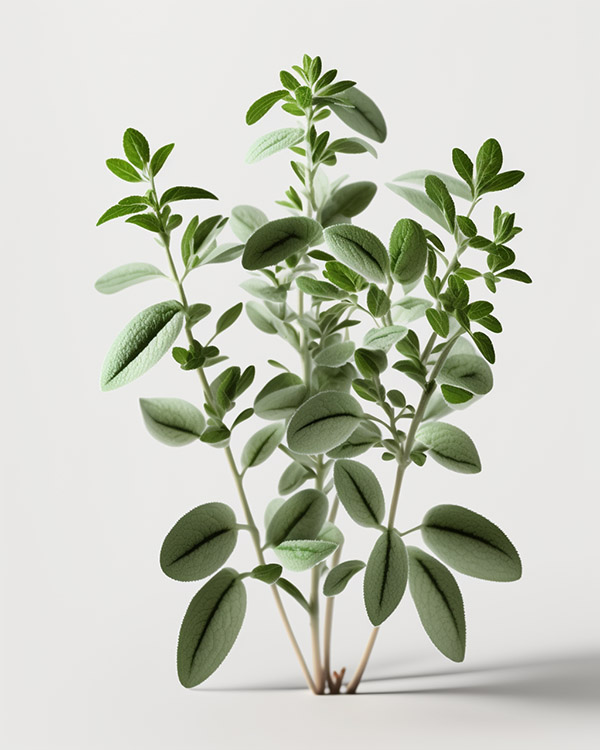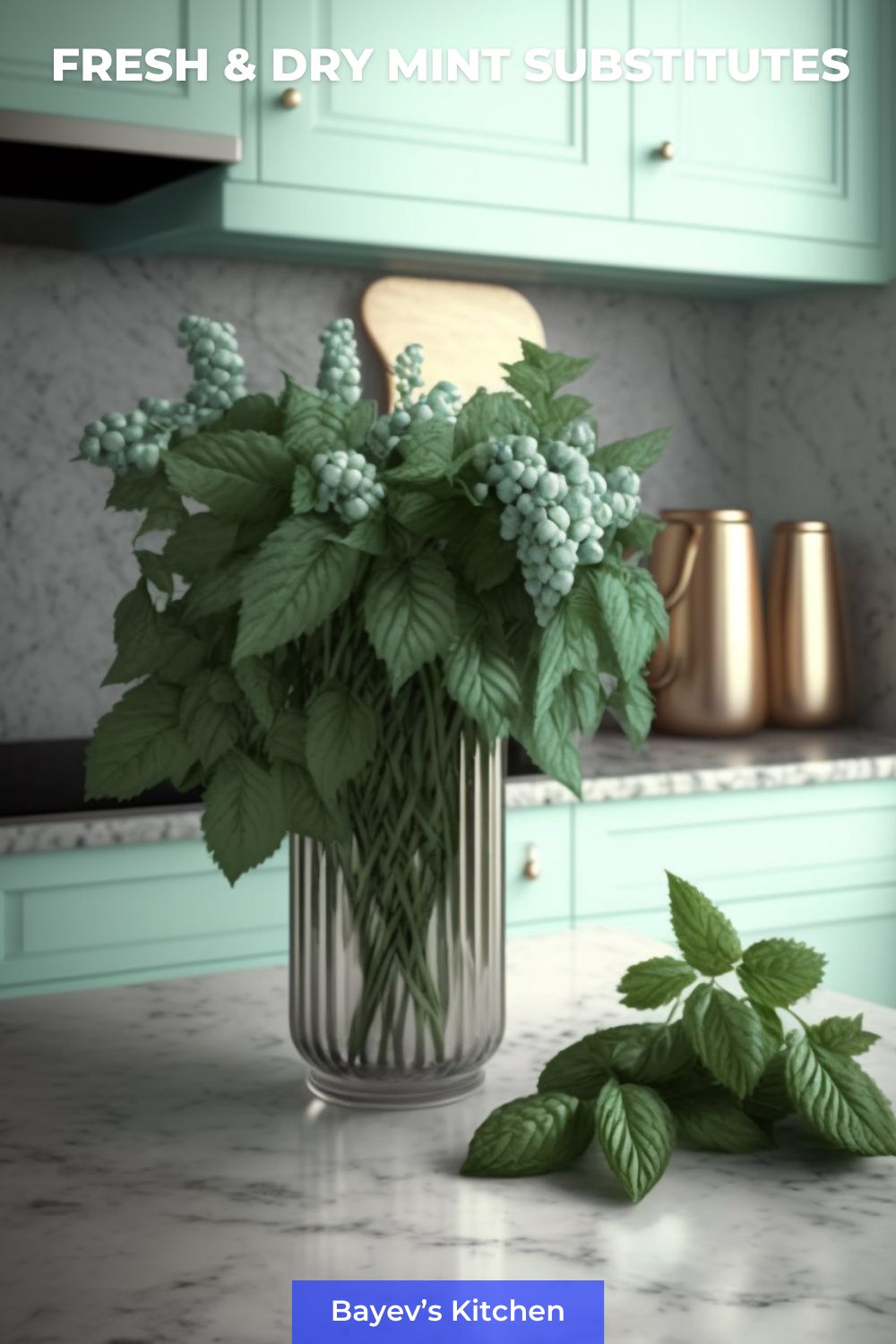At times, you may find yourself in need of a dry mint substitute, whether due to dietary restrictions, flavor preferences, or ingredient availability.
Exploring alternatives for dry mint can lead you to new and exciting flavors in your culinary creations. In this article, we’ll delve into the flavor profile of dry mint, discuss the closest replacements and other potential substitutes, and offer tips and guidance for using them effectively in your recipes.
Contents
👅 Flavor Profile
Fresh mint has a cooling, refreshing taste with a slightly sweet undertone. It imparts a clean, crisp flavor to dishes and drinks, making it a versatile ingredient in the culinary world.
The texture of fresh mint leaves is delicate and tender, and they can be used both raw and cooked. When heated, mint may lose some of its potency, so it’s best to add it towards the end of cooking to preserve its freshness.
Dry mint has a concentrated, refreshing, and slightly sweet flavor, with a cool aftertaste. The drying process enhances the herb’s aromatic qualities, giving it a more potent taste compared to its fresh counterpart. Dry mint can be used in both sweet and savory dishes, as well as beverages. Its texture is crumbly and can be easily crushed or ground for various applications.
Fresh vs. Dry Mint vs. Mint Exctract
Fresh mint, dried mint, and mint extract each offer unique characteristics for culinary use.
Fresh mint brings a crisp, refreshing flavor that enlivens cold dishes, drinks, salads, and desserts. It’s best added towards the end of the cooking process to retain its bright flavor and color.
Dried mint, due to its concentrated flavor, pairs well with hearty stews, roasts, and sauces where it has the opportunity to rehydrate and slowly release its flavor. Its more robust profile withstands longer cooking times better than fresh mint.
Mint extract, a highly concentrated form of mint flavor, is typically used in baking or sweet recipes such as chocolates, candies, or ice creams. It offers a strong, intense mint flavor and should be used sparingly; usually, just a few drops are enough.
Similarities exist in the culinary applications of both forms, such as flavoring teas or yogurts. However, the conversion isn’t a 1:1 ratio. When substituting, you’ll typically use a third of the amount of dried mint to replace fresh, due to dried mint’s concentrated flavor. But the adjustment may vary based on personal taste and recipe.
Fresh Mint Types
There are numerous varieties of fresh mint, each with distinct characteristics.
Spearmint
With its sweet, mild flavor and aroma, spearmint is widely used in both sweet and savory dishes. It’s common in Middle Eastern cuisine, salads, drinks, and sauces.
Peppermint
Peppermint has a higher menthol content, giving it a stronger, more cooling flavor. You can use peppermint as a substitute for mint (usually spearmint) in recipes. But remember, that peppermint has a more intense, pungent flavor due to its high menthol content. This strong flavor can be great for sweets, desserts, or beverages but could overwhelm savory dishes that call for a milder, sweeter mint flavor.
Apple Mint
Known for its fruity, mild flavor, apple mint is often used in salads, beverages, and garnishes.
Chocolate Mint
This variety has a subtle chocolate flavor and aroma, making it ideal for desserts and sweet beverages.
Despite their differences, these mint types all provide a refreshing flavor and aroma. In cooking, the choice between them often depends on the specific flavor profile required by the recipe. Note that peppermint’s stronger flavor may dominate a dish, while spearmint, apple mint, and chocolate mint offer more nuanced flavor profiles
What kind of mint is sold in grocery stores?
It can vary, but the most common type is spearmint.
Peppermint is also sometimes available, particularly around the holidays or in stores with a larger herb selection.
The specific type of mint should be labeled, but if it isn’t, spearmint is a safe assumption for generic “mint” in most grocery stores.
🔄 Fresh Mint Substitutes

Fresh Basil
Basil offers a sweet and slightly spicy flavor, making it a good alternative to fresh mint. Use an equal amount of fresh basil in place of fresh mint. The substitution will result in a more herbaceous and less cooling flavor.

Fresh Spearmint
Spearmint has a milder, sweeter taste compared to regular mint. Use equal amounts of fresh spearmint in place of fresh mint. This substitution will still provide a cooling effect but with a slightly different flavor profile.

Fresh lemon balm
Lemon balm has a lemony, minty flavor that can be used in place of fresh mint. Substitute fresh mint with an equal amount of fresh lemon balm. This will result in a more citrusy and less sweet taste in your dish.

Fresh Tarragon
Tarragon offers a mild anise flavor and can be used as a mint substitute. Use half the amount of fresh tarragon compared to fresh mint. This substitution will impart a licorice-like taste to your dish.

Cilantro
Cilantro provides a bright, citrusy flavor that can work as a fresh mint substitute. Use equal amounts of fresh cilantro in place of fresh mint. This substitution will result in a more savory flavor profile.

Parsley
Parsley has a mild, grassy flavor that can be used as a substitute for fresh mint. Use equal amounts of fresh parsley in place of fresh mint. This will result in a less pronounced flavor profile.

Arugula
Arugula has a peppery, slightly bitter taste that can work as a mint substitute. Use equal amounts of fresh arugula in place of fresh mint. This substitution will add a more robust, earthy flavor to your dish.

Dill
Dill offers a delicate, slightly sweet and tangy flavor that can be used as a mint substitute. Use half the amount of fresh dill in place of fresh mint. This will result in a more herbaceous and less cooling flavor.

Oregano
Oregano has a pungent, earthy flavor that can be used as a substitute for fresh mint. Use half the amount of fresh oregano in place of fresh mint. This substitution will add a more savory, robust taste to your dish.

Thyme
Thyme offers a subtle, earthy flavor that can work as a mint substitute. Use half the amount of fresh thyme in place of fresh mint. This substitution will result in a more savory, less cooling flavor profile.
⤵ Dry Mint alternatives
Dry Spearmint
This close relative of mint offers a similar flavor profile, albeit slightly sweeter. Use it in a 1:1 ratio as a direct substitute for dry mint.
Dry Lemon Balm
With its lemony-mint taste, dry lemon balm can be a suitable substitute in recipes that call for dry mint. Use a 1:1 ratio for substitution.
Dry Peppermint
Peppermint has a more intense flavor than dry mint, so use it in a 2:3 ratio to avoid overpowering your dish.
Fresh Mint
If you have access to fresh mint, you can use it as a substitute for dry mint. Since fresh herbs have a milder flavor, use three times the amount of fresh mint in place of dry mint.
Dry Tarragon
Although its anise-like flavor is distinct from mint, tarragon can work as a substitute in savory recipes. Use it in a 1:1 ratio.
Dry Basil
While its flavor is different, dry basil can add a pleasant herbal note to recipes. Use it in a 1:1 ratio as a substitute.
Dry Oregano
This pungent herb may be used in a 1:1 ratio in savory dishes, but be aware that its flavor is quite different from mint.
Dry Marjoram
Similar to oregano, dry marjoram can be used in a 1:1 ratio for savory dishes, but with a slightly sweeter flavor.
Dry Thyme
Although not a perfect match, thyme’s earthy flavor can be a suitable alternative in certain recipes. Use a 1:1 ratio.
Dry Rosemary
With its robust, piney flavor, rosemary can be used as a substitute for dry mint in savory dishes. Use it sparingly, as its flavor can be overpowering.
🫙 Mint Extract Substitutes
- Peppermint Oil. Peppermint oil is a highly concentrated form of mint flavor, derived from the peppermint plant. Use a smaller amount of peppermint oil, approximately 1/4 of what the recipe calls for in mint extract.
- Spearmint Oil. Spearmint oil, like peppermint oil, is highly concentrated and comes from the spearmint plant. Use it in a 1:4 ratio to mint extract to maintain the desired flavor intensity.
- Peppermint Tea. Steep a strong peppermint tea and use the liquid in place of mint extract. For each teaspoon of mint extract, use 3 tablespoons of the tea.
- Fresh Mint. Finely chop fresh mint leaves and add them to your recipe to infuse the mint flavor. Use around three tablespoons of chopped fresh mint for every teaspoon of mint extract.
- Mint-Infused Simple Syrup. Make a simple syrup by simmering equal parts sugar and water with a generous handful of fresh mint leaves. Strain out the leaves and use the syrup as a substitute for mint extract. Use 1-2 tablespoons of mint-infused simple syrup for each teaspoon of mint extract.
- Mint-Flavored Liqueur. Using a mint-flavored liqueur, like crème de menthe, can work as a substitute for mint extract in some recipes. Since it is less concentrated, use 2-3 teaspoons of liqueur for every teaspoon of mint extract. Keep in mind that this will add alcohol to the recipe, so it may not be suitable for all dishes.
Vietnamese Mint Substitutes
Vietnamese mint, also known as Vietnamese coriander or Persicaria odorata, is a popular herb in Southeast Asian cuisine, with a unique flavor profile that combines the taste of mint, cilantro, and lemon. Here are some substitute ideas if you’re unable to find Vietnamese mint:
- Regular Mint and Cilantro Combo. Combine equal parts of regular mint (spearmint or peppermint) and cilantro to recreate the flavor of Vietnamese mint. This mixture will provide a similar fresh and aromatic taste, but with a slightly different flavor profile.
- Lemon Balm. Lemon balm is a member of the mint family, and its citrusy undertones make it an excellent substitute for Vietnamese mint. However, it is milder in flavor, so you may need to use more of it to achieve the desired taste.
- Thai Basil. Thai basil has a distinct anise and licorice flavor, which can be an interesting alternative to Vietnamese mint. While it won’t perfectly replicate the taste, it does bring a unique and refreshing flavor to your dishes.
- Perilla (Shiso). Perilla, also known as shiso or beefsteak plant, is another Asian herb with a somewhat similar flavor to Vietnamese mint. It has a slightly minty and anise-like taste that can work as a substitute in Vietnamese dishes.
- Lime Zest and Regular Mint. Mix lime zest with regular mint to mimic the lemony-mint flavor of Vietnamese mint. This combination will create a refreshing, citrusy taste that can be used in salads, noodle dishes, and dipping sauces.
Remember, these substitutes may not perfectly replicate the taste of Vietnamese mint, but they will provide a unique and flavorful twist to your dishes.
🍳 Substitution by Meal Type
Mojito
You could use lemon balm or basil instead of mint. Lemon balm has a lemony-mint flavor, making it a great alternative in a 1:1 ratio. Basil, particularly Thai basil, offers a unique twist with its sweet and slightly spicy taste, also used in a 1:1 ratio.
Tzatziki
Dill or parsley can be excellent mint substitutes in tzatziki. Dill brings a fresh, slightly tangy flavor to the sauce, using a 1:1 ratio. Parsley offers a milder, slightly bitter taste, used in a 1:1 ratio as well.
Tabbouleh
For tabbouleh, try parsley or cilantro. Parsley is a common ingredient in tabbouleh and can be increased in a 1:1 ratio to compensate for the lack of mint. Cilantro brings a bright, citrusy flavor to the dish, also used in a 1:1 ratio.
Lamb dishes
Rosemary and thyme are excellent alternatives to mint for lamb dishes. Rosemary imparts a robust, piney flavor, so use it sparingly (1:2 ratio). Thyme has an earthy taste and can be used in a 1:1 ratio.
Moscow Mule
Lemon verbena or basil can be used as mint substitutes in Moscow mules. Lemon verbena adds a zesty, lemony note, used in a 1:1 ratio. Basil provides a sweet, aromatic flavor, also used in a 1:1 ratio.
Juleps
For juleps, consider using lemon balm or spearmint. Both offer similar cooling, refreshing flavors in a 1:1 ratio.
Curry dishes
In curry dishes, cilantro or Thai basil can replace mint. Cilantro has a bright, citrusy flavor, used in a 1:1 ratio. Thai basil adds a sweet, anise-like note in a 1:1 ratio.
Tea
Lemon balm and lemongrass can serve as mint substitutes in tea. Lemon balm provides a lemony-mint taste in a 1:1 ratio, while lemongrass imparts a refreshing, citrusy flavor, also used in a 1:1 ratio.
Salads
For salads, try substituting mint with basil or parsley. Basil adds a sweet, aromatic flavor, while parsley brings a fresh, slightly bitter taste. Both can be used in a 1:1 ratio.
Baked Dishes
In baked dishes, consider using thyme or oregano as mint substitutes. Thyme’s earthy flavor and oregano’s pungent taste work well in savory dishes. Use either herb in a 1:1 ratio.
Grill Dishes
For grill dishes, rosemary or cilantro can replace mint. Rosemary’s robust, piney flavor should be used sparingly (1:2 ratio), while cilantro’s bright, citrusy taste can be used in a 1:1 ratio.
💡 Tips and Guidance
- When using fresh herbs as a substitute for dry mint, remember that fresh herbs have a milder flavor and require a larger quantity for substitution.
- Experiment with different combinations of dry mint substitutes to achieve a unique flavor profile in your dishes.
- Taste your dish while cooking, and adjust the amount of substitute herb according to your preference.
- Be mindful of the potency of some substitutes, such as dry rosemary or dry peppermint, and adjust the ratio accordingly to prevent overpowering your dish.
- When using dry mint substitutes in beverages, start with a smaller amount and adjust according to taste, as some alternatives may have a stronger flavor.
- Taste your dish while cooking and adjust the amount of substitute herb according to your preference.
- For a unique twist, combine two or more fresh mint substitutes to create a new and interesting flavor profile in your dishes.
- When using essential oils, like peppermint or spearmint oil, as a substitute for fresh mint, start with a small amount (1-2 drops) and adjust according to taste.

